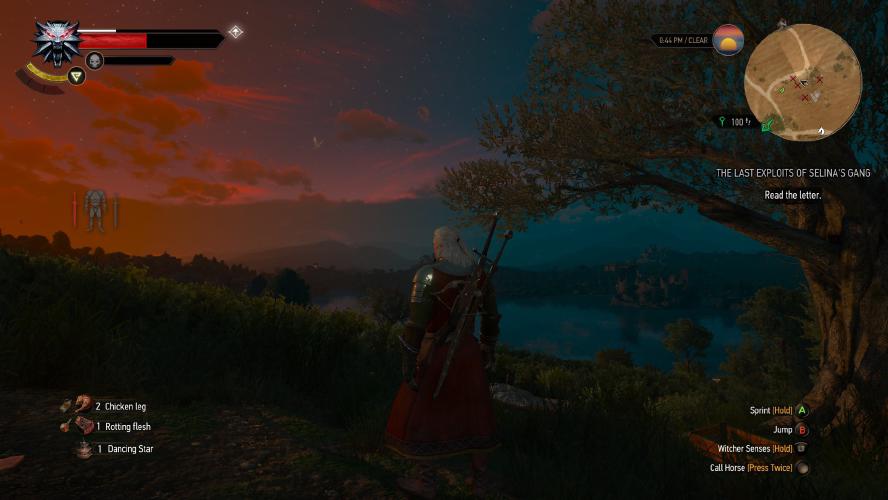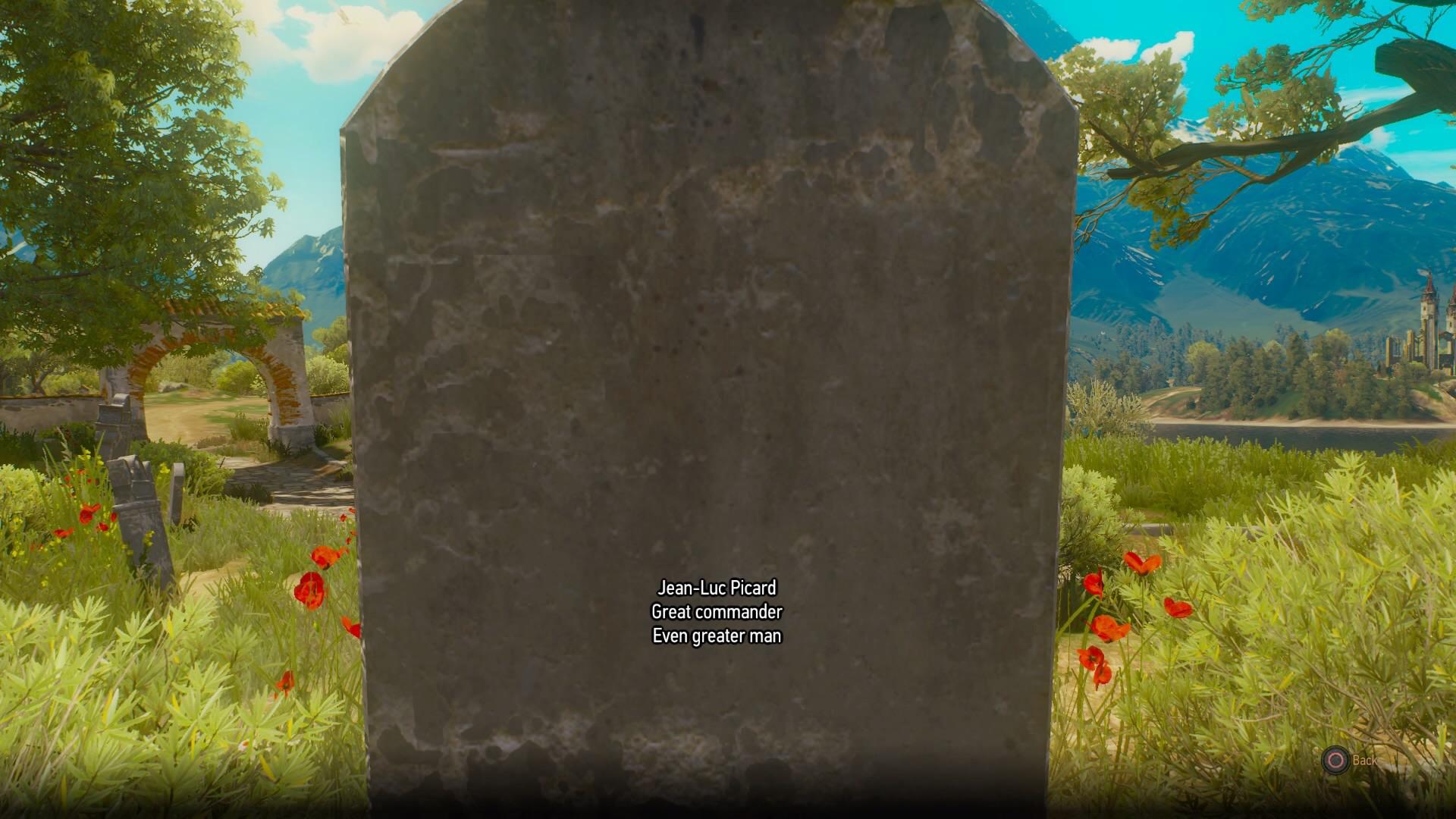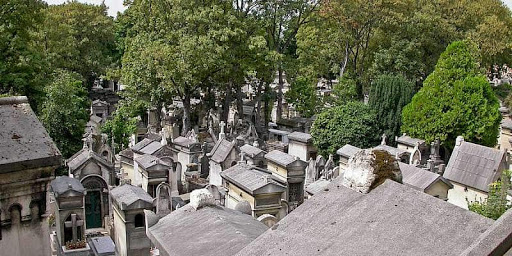Graveyards: The Grand, the Grown, and the Ghouls

“We are literally atop untold histories: things, ideas, lives, and activities that we have never seen before, that we may know nothing of, and that can thus endlessly surprise and transform us.”1
This final “work” week in Digital Archaeology was collaborative in ways I never anticipated. Specifically, I discovered that my “gamer” skill set only goes about as far as Stardew Valley (which also has some element of archaeology, however questionable it may be– but that’s a different story), and I had to ask my partner to play The Witcher 3: Wild Hunt for me because I kept getting killed before actually reaching any cemeteries. While my actual attempt at playing the game was a fail, in the end, getting to watch was a win because it meant I could take notes as observations happened! It was also a win for my partner, who enjoyed using the fact that he had to play a video game for me as an excuse to avoid his actual work.
Approaching this task of archaeogaming, I did a bit of research beforehand about the possible cemetery I could virtually visit and discovered that there were actually two that were readable in Witcher 3. Now, I could have visited just one, but I wondered what differences there might be across cemeteries in this world if any, and thought that in comparing them, I might be able to uncover intricacies that looking at a singular cemetery wouldn’t reveal. Following this, I hunkered down for an evening of what I thought would be some relaxing world exploration on horseback, the approximate locations of the cemeteries Orlémurs and Mère-Lachaiselongue on hand because Witcher 3 doesn’t provide coordinates nor a very detailed map.
The first cemetery I visited, Orlémurs, was just outside of a large city temple yet seemingly abandoned; although the front area by the entrance wasn’t very overgrown, as you moved back towards the river the cemetery was situated beside, the likely “older” graves were in various states of disrepair and there were drowners circling who would attack if you got too close. Using the power of my mighty boyfriend, I slew them and got to work recording the site; there were no significant differences between those buried at the back of the cemetery versus the front as I anticipated due to the lurking monsters. A wide range of individuals were buried throughout the cemetery– from travellers to nobility, and even starship captains:

…none of whom were placed in a specific arrangement or sectioning. Despite this, there was still one grave that stood out– the grave of Tomas Moreau, a professor who’s headstone’s inscription was written in Elder Speech (the fictional language of scholars, mages, and elves in-game), was the only grave in the cemetery to have been looted and left in total disarray. My partner confirmed that this could be significant, because the city that this cemetery was located in was predominantly occupied by Northerners, who are known to persecute elves and whose cities are often built over former elven kingdoms following conquests. Interesting.
The headstone models themselves were not unique, but each headstone had the format of a full name followed by, rarely, a career, but always an epitaph, many of which were comedic in nature. As I moved on to the next cemetery, I expected little difference with a name like Mère-Lachaiselongue, which is evidently a parody of Père-Lachaise Cemetery, France’s largest and most visited burial ground. This in-game site certainly lived up to its real-world counterpart with its hilly landscape and graves place so closely that they overlapped, albeit much more overgrown and decrepit.
Père-Lachaise Cemetery Mère-Lachaiselongue Cemetery

Unlike its real-world counterpart (I hope) was the fact that there was a flower monster thing guarding the cemetery’s entrance the seemingly spawn ghouls. I was NOT a fan of that, but it was soon defeated and I was able to explore… with caution. While what was written on the headstones wasn’t formatted any differently from Orlémurs, the memorials themselves were often much more grand, featuring tombs accompanied by life-sized statues or alters. Despite the cemetery’s seemingly abandoned state, accompanying these graves was numerous offerings of coins and expensive weapons or jewels (that you, the player, could loot…), so this combined with the elaborate monuments and frequent mentions of ties to nobility lead me to believe that those buried here were likely a bit wealthier than those buried at Orlémurs.
We found another uncovered grave at Mère-Lachaiselongue, but this time there was no option to read the inscription and a significant amount of riches had been left behind, so either this grave was in such an “open” state because of weathering or whoever uncovered it was looking for something specific… I haven’t got far enough into this storyline to know if there’s any significance, so I don’t actually know the answer to this. I also don’t know why all of the presumably female statues featured at the heads of tombs were always missing their torsos:

A misogynistic monster? A vengeful mason who didn’t get paid? Life is full of mysteries.
Reflecting back on this experience, the first thing that I noticed was that, unlike when I was told to investigate a real cemetery at the beginning of the semester, when asked to investigate a virtual cemetery I had no moral qualms with it and did not think twice about doing this task. Now, I’m sure this is mostly related to the fact that I’m aware the cemetery I visit in a high fantasy video game is going to be fictional, but this realization made me think of how creatively representing sites of memorialization virtually may alter their impact. I recalled the González-Tennant article where he discusses virtually reconstructing the destroyed historic site of Rosewood, Florida– both through a virtual museum in Second Life and an actual model of the community that was explored through Google Earth. Ultimately, creating historical experiences such as this virtually is important for the purpose of creating publically accessible information and engagement; but, by transferring these important histories into a virtual environment– an environment many presently associate with playing games– will they actually be affected by what’s being displayed to them? Will they be able to truly grasp the gravity of the histories being told, or will this get downplayed or overshadowed by the novelty of a virtual world to explore? I personally feel that when the physicality of history is removed, so is some of my ability to connect with it. The feeling that the quote I opened with today conveys– the feeling of being literally atop untold histories, present in the past– is the key element of history and archaeology that I find enchants me but isn’t something a virtual world can connect me to.
Don’t mistake this as me feeling nothing while navigating the cemeteries of Witcher 3 though, I’m far too emotional for that. I disliked that a significant incentive to seek out these cemeteries for a player is because the graves contained many valuable items which one could loot. I remember in the Mère-Lachaiselongue crypt, there was a knight buried there with a sword over his tomb; if you approach the tomb and interact with it, you get a letter written by the knight himself about the significance of the sword to him and his burial… but then you also pick up the sword (no option to put it back). Looting is common in games, and can be fun, but the concept of looting in a cemetery slightly upset me, because my brain was connecting this action specifically with the real-world reflections it carries. Yes, looting a fictional abandoned cemetery in a video game has no repercussions and only benefits, but does having it be something to do in a game translate to normalizing cemeteries as a commodity in our reality? We know that there are a significant numbers of items– jewellery and skeletal remains alike– robbed from graves and sold on platforms as common as Etsy. Further, I remember when I was doing my own work with the cemetery at Pinhey’s Point; upon discussing it with my peers in our Discord server, one of them shared that they’re a member of the congregation that holds ownership over the site and then thanked me for simply asking permission to visit the site, and so did the caretakers. Apparently, despite the massive “PRIVATE PROPERTY: NO ENTRY” sign accompanied by the large section of dense tree cover and tall hedge that separates the cemetery from the Pinhey’s Point Historic Site, people still frequently attempt to enter the cemetery with no prior approval. Many seem to believe that cemeteries are spaces for entertainment– a cool or “spooky” place to go for thrills, where they might see a ghost or uncover something interesting like a bone that, because its uncovered, is free to take with them as a souvenir. While I’m sure there are many aspects of history that have led to these once largely respected spaces becoming something to plunder, I feel that the encouraging cemeteries to be visited with one of the purposes being to loot them only continues to build upon this.
Graveyard Grandeur
Yep, I had a lot of thoughts this week, so we’re throwing it back to my HIST3814 method of blogging and splitting activities into sections. Not too much further, I promise!
On the topic of HIST3814, I remember sonification being introduced in that course, but at the time I wasn’t quite sure about the concept of hearing history, and frankly wasn’t confident enough in my ability to get THAT creative with data, so I chose the equally informative but arguably less wild activities of StoryMaps and academic posters. But no fear this time– when sonification was once again proposed to me as an activity, I immediately put it on my to-do list for the week.
I started by looking at the notebook we were given to see how sonification worked at a base level. I had never produced sound from code before, let alone from data, so this gave excellent insight to the mechanism behind sonification… BUT I ended up not quite understanding how to get my data working with this code in a way that could produce a clean sound, thus I moved on to the easier option of Two Tone, which allowed me to simply import my data and go! All in an easy-to-understand web interface! I played around with the data for a bit first to get used to the site’s functions, but quickly got the hang of it and then moved on to the real question that puzzled me since HIST3814: how can I make something meaningful from this, and preferably, somewhat pleasant-sounding? I struggled with this as my earlier attempts at interpreting our course’s graveyard data proved to be unsuccessful in the form of sonification, and so I stared at the dropdown list of columns that Two Tone presented to me, just randomly clicking and listening to what was produced trying to come up with something that could have meaning. I eventually listened to the measurement of headstone height, which had some form of melodious sound, and then I thought, “but what meaning could come from height?” I scrolled through the other variables once again, and slowly pieced together the concept of looking at the grandeur of headstones overtime. The size, the decorative motifs, the inclusion of quotes and text panels– all could be indicators of trends in memorialization over the period of 1815 to 2015. As far as I could tell, Two Tone did not offer a way to sort data in-application, so I quickly did so myself then reimported the data points so they were ordered by earliest to latest. I anticipated that we would see the elaborateness of headstones increase as technology improved, so I began the process of creating tracks for all the relevant data in hopes of seeing whether or not this hypothesis might hold true.
Right off the bat, the arrangement didn’t sound terrible– in my notes, I described it as “someone trying to make medieval Eastern European music but they aren’t entirely sure what that is and they don’t have the right instruments.” With some fiddling, I came up with the following:
- Height as harp, represented by x3 ascending tempo, the “climb” indicating that it is “moving” upwards
- Presence of quotes indicated by the glockenspiel
- Length/thickness of monument as a double bass, to represent the “low-ness” of tombs/crypts
- The central decorative motifs as a church organ, because there were only 2 occurrences of this recorded so I wanted a very present noise to highlight them
- Marginal decorative motifs as a violin & text panels as a piano, simply because they sounded nice and could be distinguished from the other instruments
What was created, in my opinion, sounds like a song from the soundtrack of a Professor Layton game:
Alternatively, at one point I accidentally changed height from being represented by a harp to an oscillator, and produced a slightly more nightmare-ish version:
So, what do you hear?
I found that, despite my previous doubts, you can of course finding meaning from sonification. The consistent “hammering” of the glockenspiel tells me that quotes have consistently been a feature of headstones across the centuries. Additionally, the sound as a whole was fairly consistent, proving my initial thought the decoration would increase over time, wrong.
Now, there are some flaws in this data, the most significant one being that for the track to be truly accurate to the timeline, it would actually have to end after 2:01. There were a number of graves that did not have a date of creation included in their data, therefore when I sorted the data, all 46 of these points were pushed to the end. Additionally, I’m still not sure how I feel about the process of sonifying data– this was by far the most “artistic” interpretation of data I’ve done with many choices made about it that came down to personal taste. My influence on this data is explicit, but then, who says this always has to be a bad thing? Although getting creative with archaeological data can run the risk of misinterpretation when some intricacies may have to be altered or removed in the process of making the data usable, if the overall message can be conveyed to those engaging with the output, is this so bad? With explicit details given on the process of creation, such as what I just described with my foray into sonification, not only can Perry’s concept of archaeological enchantment be experience by the archaeologists who get to experiment with these creative ways of interpreting their findings, but by the public as well, who get to learn about their past in ways they never fathomed to be possible.
1 Perry, Sara. 2019. The Enchantment of the Archaeological Record. European Journal of Archaeology. 22.3, 354-371.